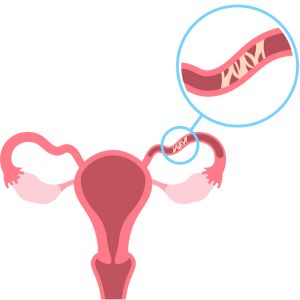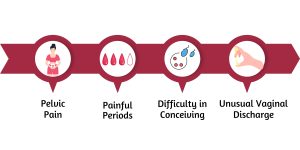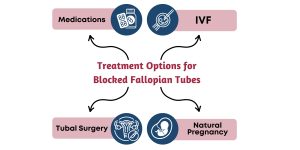Blocked fallopian tubes are a significant cause of female infertility, affecting approximately 25-30% of women with fertility issues. These tubes play a crucial role in natural conception, as they facilitate the meeting of the egg and sperm for fertilization. When blocked, this natural process is hindered, making pregnancy challenging. However, the possibility of pregnancy with blocked fallopian tubes depends on several factors. In this blog, we will explore the causes, symptoms, diagnosis, treatment options, and the potential for pregnancy despite having blocked fallopian tubes.
Understanding the Fallopian Tubes
The fallopian tubes are two thin tubes located on either side of the uterus. During ovulation, the ovary releases an egg into the fallopian tube, where it may meet sperm and become fertilized. The fertilized egg then moves down the tube to the uterus for implantation. Blockages can prevent the sperm from reaching the egg, or the fertilized egg from reaching the uterus, thus preventing pregnancy.

Causes of Blocked Fallopian Tubes
Several factors can lead to blocked fallopian tubes, including:
- Pelvic Inflammatory Disease (PID): PID is an infection of the reproductive organs, often caused by sexually transmitted infections (STIs) like chlamydia or gonorrhea. The infection can cause inflammation, scarring, and adhesions in the fallopian tubes, leading to blockages.
- Endometriosis: Endometriosis occurs when the tissue that normally lines the inside of the uterus grows outside of it, affecting the fallopian tubes and surrounding organs. This can cause scarring and blockages.
- Ectopic Pregnancy: An ectopic pregnancy occurs when a fertilized egg implants and grows outside the uterus, typically in the fallopian tube. This can lead to damage and scarring of the tube, causing a blockage.
- Previous Surgeries: Surgeries involving the reproductive organs, such as surgery for ovarian cysts or fibroids, can lead to scar tissue formation, which may block the fallopian tubes.
- Congenital Abnormalities: In rare cases, women may be born with structural abnormalities in their fallopian tubes that lead to blockages.

Symptoms of Blocked Fallopian Tubes
Many women with blocked fallopian tubes may not experience any noticeable symptoms and may only discover the issue when trying to conceive. However, some signs and symptoms that might indicate a blockage include:
- Pelvic Pain: Persistent or intermittent pain, particularly during menstruation or ovulation, may suggest a problem with the fallopian tubes.
- Painful Periods: Severe menstrual cramps can sometimes be a sign of conditions like endometriosis, which can cause tubal blockages.
- Unusual Vaginal Discharge: A thick or abnormal discharge could be indicative of an infection, such as PID, which can lead to blocked tubes.
- Difficulty in Conceiving: The most common indication of blocked fallopian tubes is difficulty conceiving after a year of regular, unprotected intercourse.

Diagnosing Blocked Fallopian Tubes
Several diagnostic methods are used to detect blocked fallopian tubes:
Hysterosalpingography (HSG): An X-ray test where a dye is injected into the uterus and fallopian tubes. If the dye flows freely through the tubes, they are likely not blocked. If the dye does not pass through, it indicates a blockage.
Sonohysterography: An ultrasound-based procedure where saline is injected into the uterus. This helps visualize the fallopian tubes and identify any blockages.
Laparoscopy: A laparoscope, a thin, lighted tube, is inserted through a small incision in the abdomen to directly view the fallopian tubes and other reproductive organs. This procedure allows for both diagnosis and treatment of blockages.
Chlamydia Antibody Test: This blood test checks for antibodies against chlamydia, which can indicate a past infection that may have caused damage to the fallopian tubes.
Emotional and Psychological Impact
Coping with blocked fallopian tubes can be emotionally difficult. The uncertainty and difficulty in conceiving naturally can lead to stress, anxiety, and feelings of inadequacy. It’s essential to seek support from loved ones, join support groups, or consider counseling to navigate these feelings.
Maintaining a positive outlook, exploring all available treatment options, and understanding that you’re not alone in this journey can make a significant difference. Many women with blocked fallopian tubes have successfully conceived with the help of medical interventions like surgery or IVF.

Treatment Options for Blocked Fallopian Tubes
The treatment for blocked fallopian tubes depends on the severity and location of the blockage, as well as the woman’s overall health and fertility goals.
Medications
If the blockage is due to an infection or inflammation, antibiotics may be prescribed. These medications help treat the infection and reduce inflammation, potentially restoring normal function to the fallopian tubes.
In Vitro Fertilization (IVF):
When both fallopian tubes are blocked or surgery isn’t an option, IVF is often recommended as a solution. By bypassing the fallopian tubes entirely, eggs are retrieved directly from the ovaries, fertilized in a laboratory, and the resulting embryos are transferred into the uterus. This approach offers a higher success rate for women with tubal infertility compared to other treatments. However, success rates vary depending on factors like age, the quality of the embryos, and the cause of infertility.
Related- Is IVF Right for You? Exploring Fertility Treatment Options.
Tubal Surgery
- Salpingectomy: Removal of the damaged part of the fallopian tube, usually in cases of hydrosalpinx, to improve the chances of a successful IVF.
- Fimbrioplasty: Reconstruction of the fimbriae (the finger-like projections at the end of the fallopian tube) to restore normal function.
- Tubal Cannulation: A procedure to unblock the fallopian tubes using a catheter, often performed during an HSG or laparoscopy.
- Tubal reanastomosis: Reconnecting the tubes after a tubal ligation to restore fertility. Success rates vary depending on the amount of scar tissue and the patient’s age.
Natural Pregnancy:
- Partial Blockage: If only one tube is blocked, or if there’s a partial blockage, natural conception might still be possible. The open tube can allow the egg and sperm to meet, although the chances are lower compared to having both tubes open.
- Monitoring and Timing: Women with partial blockages can increase their chances of natural conception by closely monitoring ovulation and timing intercourse accordingly.

Conclusion
Blocked fallopian tubes are a significant cause of infertility, but they don’t necessarily mean that pregnancy is impossible. While natural conception may be difficult or unlikely, modern fertility treatments offer hope. Whether through surgery, IVF, or other interventions, many women with blocked fallopian tubes go on to have healthy pregnancies and successful deliveries.
If you suspect or have been diagnosed with blocked fallopian tubes, consult a fertility specialist to discuss your options. With the right approach and support, your dream of becoming a parent can still be within reach.
